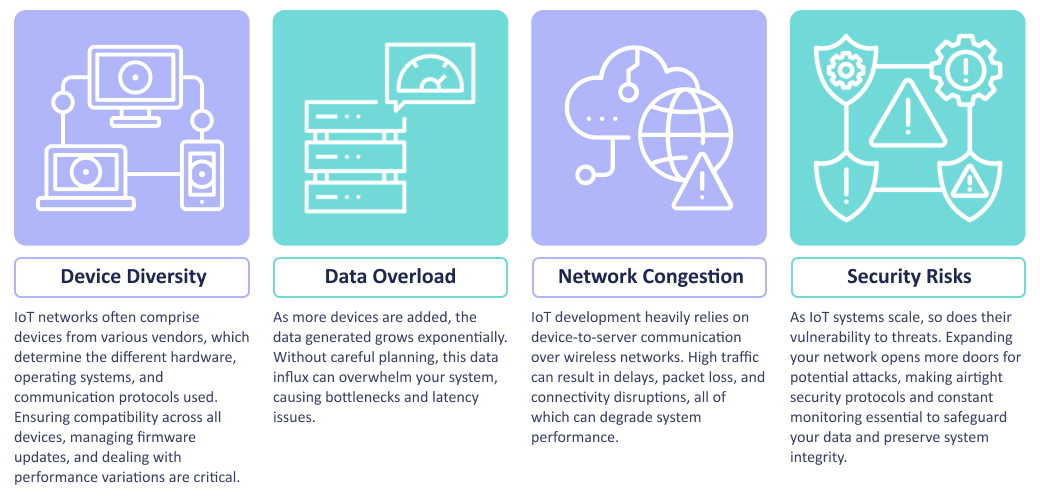Forward-Looking IoT Development: Building for Future Growth
Picture this: thousands of interconnected devices, each producing terabytes of data, all working in perfect harmony and securely. It's no small feat.
Yet, future-proofing your IoT development to accommodate growth isn't just desirable – it's essential. While most IoT deployments start on a small scale, they inevitably need to expand as more devices, users, and data points come into play. Most successful IoT products face the necessity of scaling within just one or two years of hitting the market.
This is why scalability should be a cornerstone of your IoT development strategy, addressed long before your product launch. This article explores essential principles to help you tackle scalability upfront, ensuring your enterprise IoT solution operates smoothly throughout its lifecycle.
IoT Development: When Should You Consider IoT Scalability?
Scalability is the ability of a system to handle increasing demands by adapting its architecture, resources, or functionalities. In the context of IoT development, this means ensuring that the system can integrate more devices, process higher volumes of data, and maintain real-time performance without compromising efficiency. The key feature and demand of any evolved IoT ecosystem is its ability to scale up or down based on the amount of data generated by devices in the network.
For product owners, scalability means that IoT-enabled services can easily be extended to new locations, integrate new features, and handle sudden user surges. For system integrators, it’s about building an IoT ecosystem that can maintain superior performance even when network traffic spikes. Whatever your role in the process, having a clear architectural vision and thoroughly exploring all potential use cases is critical for long-term success.
To meet future IoT scalability demands, you need to tap into a full stack of knowledge from the very start. A cohesive team of hardware, software, and connectivity experts – who have hands-on experience in IoT deployment – can pinpoint the vital connections needed to ensure your system operates seamlessly in scalable environments that match your business goals.
Scalability Challenges in IoT Development
Scaling IoT systems comes with a unique set of challenges, far beyond those seen in traditional software development. These arise from the nature of IoT devices, the sheer volume of data generated, and the need for real-time responsiveness.
The key challenges include:

Key Strategy Components of IoT Development
Modular Architecture for IoT Development
A modular architecture is the backbone of scalable IoT development. By designing systems with interchangeable components, businesses can easily upgrade or expand their IoT networks. This approach enables each system module – whether for device management, data storage, or analytics – to be scaled independently, eliminating the need for time-consuming and resource-intensive redesigns. For example, as your number of connected devices grows, you can allocate more storage or computing power to analytics without affecting the overall system.
Experience shows that the modular approach is a core thing to minimize downtimes and reduce the complexity of integrating new devices or technologies into the IoT ecosystem.
Cloud Integration for IoT Development
Cloud platforms are vital for scaling IoT systems, as they provide businesses with a robust space for storing, processing, and analyzing huge quantities of information. Cloud infrastructure provides the elasticity needed to handle fluctuating workloads. As your IoT system scales, the cloud can automatically augment resources – whether it’s computing power, storage, or bandwidth – to meet growing demands at the moment.
Major cloud providers like AWS IoT, Microsoft Azure IoT, and Google Cloud IoT offer tools that make managing IoT networks easier. In particular, real-time monitoring, predictive maintenance, profound business intelligence, and other applications are becoming more affordable. Hybrid cloud systems that blend public and private cloud setups and may involve legacy infrastructure offer even greater flexibility, ensuring smooth scalability while simplifying maintenance and updates.
Edge Computing for IoT Development
As your IoT ecosystem grows, sending all data to a central processing unit for processing can dramatically affect the response time and lead to network congestion. Edge computing addresses this by processing the data closer to the source of generation. As a rule, devices themselves or local gateways are responsible for this. Distributed infrastructures promote advanced responsiveness, enabling instantaneous applications, such as industrial automation or unmanned vehicles. At the same time, edge-enabled IoT development releases substantial cloud resources to hold analytical operations and enhance real-time decision-making.
Edge computing also improves system resilience. If your central server is temporarily unavailable, edge devices can continue to function independently, ensuring the system stays operational.
Robust Security Framework for IoT Development
From a security perspective, every system node is a potential attack point, so scaling exacerbates the issue by default. A scalable security framework should be in place to safeguard data, devices, and communication channels as your network grows.
Implement robust authentication mechanisms like full-duplex authentication, digital certificates, and role-based access control to ensure only authorized devices have network access.
Encrypt data transfer between IoT devices and the cloud to prevent interception or tampering. The TLS protocol can be considered a reliable solution to ensure data confidentiality. The encryption method has proven itself as a top solution for safety-critical applications, such as PTC communication systems.
Use over-the-air (OTA) updates to push firmware upgrades and security patches to devices across your network. This ensures your system remains secure without manual intervention.
IoT Development: Data Management & Analytics
IoT devices generate overwhelming quantities of data, much of which can be redundant or irrelevant. Efficient data management involves thorough filtering, aggregation, and compression to ensure that only the most valuable data is sent to the cloud, lowering the load on your system. Scalable storage solutions like distributed databases or data lakes allow for seamless system growth through effective data storage and retrieval. Using time-series databases helps organize data from sensing devices for simplified access and analysis by organizing it chronologically.
Artificial Intelligence, inter alia, Machine Learning enables deep-dive analysis of local and external IoT data to derive meaningful insights. This elevates trend predictions, failure and overload prevention, and capacity planning under scalability goals.
IoT Development: Interoperability & Standardization
When it comes to scaling IoT systems, interoperability is a game-changer. With devices from different manufacturers running on varying protocols, integration can quickly become a headache. The solution? Embrace standardized communication protocols like MQTT, CoAP, and LwM2M. These lightweight, IoT-ready protocols are tailor-made to support diverse devices and platforms. By tapping into open standards, you ensure that all devices speak the same language, enabling your IoT solution to scale smoothly – no more getting stuck with proprietary tech that limits your flexibility.
Final Thoughts on IoT Development
You can’t avoid scalability considerations when planning IoT development. By addressing scalability before any development activities, you set your product up for long-term success, helping it adjust to a volatile operational environment.
-
Keep scalability in mind from the project discovery phase to create optimal use cases and product architecture.
-
A modular approach is required for every layer of IoT system architecture, from hardware design to network deployment. This removes the need for a complete redesign to meet scalability requirements.
-
Drive your system’s flexibility by developing integrated infrastructures that involve both cloud and edge data processing.
-
Scalable storage solutions like distributed databases and data lakes are essential for managing data growth. As your system scales, these tools ensure efficient data storage and retrieval, keeping performance optimized even with increasing data volumes.















